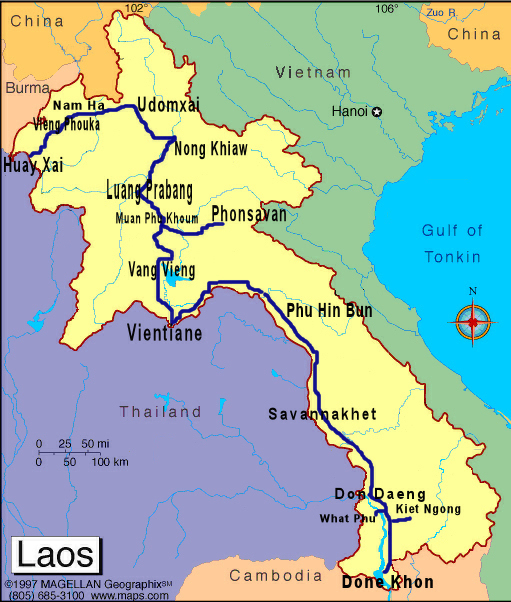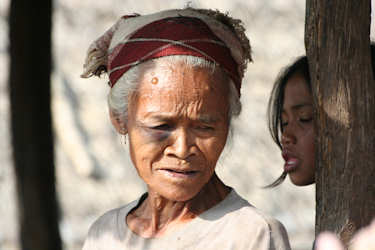Laos

Historie
Stone tools discovered in Houaphanh and Luang Prabang provinces attest to the presence of prehistoric man in the hunter-gatherer
stage in Lao territory from at least 40.000 years ago.
Agriculturist society seemed to appear during the 4th millennia BC as evidence has been found by archeologists. Burial jars and other kinds of
sepulchers have revealed a complex society in which bronze objects appeared around 1500 BC and iron tools were known since 700 BC.
The proto-historic period is characterized by contact with Chinese and Indian civilizations.
Between the fourth and eighth century, communities along the Mekong River began to form into townships, called Muang.
This development culminated in the formation of the Lane Xang (million elephant) Kingdom in 1353 by King Fa Ngum and established
Xieng Thong (now known as Luang Prabang) as the capital of Lane Xang Kingdom.
The Kingdom was further expanded by King Fa Ngum’s successors, one of the most notable being King Setthathirath who ruled from 1548-1571. He
moved the capital to Vientiane and built the That Luang Stupa, a venerated religious shrine, and a temple to house the Pra Keo, the
Emerald Buddha.
In the 17th Century, under the reign of King Souliyavongsa (1637-1694), the Lane Xang Kingdom entered it’s most illustrious era. The country
established first contacts with Europeans. In 1641, a Dutch merchant of the East India company, Geritt van Wuysthoff, and later, the
Italian missionary Leria de Marini, visited the Kingdom of Lane Xang and described Vientiane as the “most magnificent city of Southeast
Asia”.
This golden age was followed by in-fighting for the throne, which in 1707 led to the break-up of Lane Xang into the three kingdoms: Vientiane,
Luang Prabang and Champasack. The Lao kingdoms remained independent until 1779 when they then would become vassals to Thailand.
However, the kingdoms maintained their monarchical roots and a degree of autonomy.
Laos was put under the French administration in 1893. Laos never had any importance for France other than as a buffer state between Thailand and
the more economically important Annam and Tonkin.
Under the French rule, the Vietnamese were encouraged to migrate to Laos, which was seen by the French colonists as a rational solution to a
practical problem within the confines of an Indochina-wide colonial space.
During the First Indochina War (1946-1954) , the Indochinese Communist Party formed the Pathet Lao independence organisation.
The Pathet Lao began a war against the French Colonial forces with the aid of the Vietnamese independence organisation (the Viet Minh).
In 1950 the French were forced to give Laos semi-autonomy as an "associated state" within the French Union. France remained in de facto control
until 22 October 1953, when Laos gained full independence as a constitutional monarchy.
In 1955, the US Department of Defense created a special Programs Evaluation Office to replace French support of the Royal Lao Army against
the communist Pathet Lao as part of the US containment policy.
Massive aerial bombardment against the Pathet Lao and invading People's Army of Vietnam forces were carried out by the United States to
prevent the collapse of the Royal Kingdom of Laos (1953-1974) central government, and to deny the use of the Ho Chi Minh Trail to
attack US forces in the Republic of Vietnam.
Between 1964 and 1973, the U.S. dropped two million tons of bombs on Laos, nearly equal to the 2.1 million tons of bombs the U.S. dropped on Europe
and Asia during all of World War II, making Laos the most heavily bombed country in history relative to the size of its population. Some 80
million bombs failed to explode and remain scattered throughout the country, rendering vast swathes of land impossible to cultivate and killing or
maiming 50 Laotians every year.
In 1975 the Pathet Lao, along with the Vietnam People's Army, and backed by the Soviet Union, overthrew the royalist Lao government, forcing
King Savang Vatthana to abdicate on 2 December 1975.
Pathet Lao government under Kaysone Phomvihane renamed the country as the Lao People's Democratic Republic and signed agreements
giving Vietnam the right to station armed forces and to appoint advisers to assist in overseeing the country.
Laos depended heavily on Soviet aid channeled through Vietnam up until the Soviet collapse in 1991.
In the 1990s the communist party gave up centralised management of the economy but still has a monopoly of political power.
Kaysone died in November 1992, and was succeeded as President by Nuhak Phumsavan. In 1998 Nuhak retired and Khamtay Siphandone succeeded
him as President, a post he continued to hold until 2006
I visit Laos in december 2007
These are the places I have seen on that trip
Huay Xai
Vieng Phouka
Nam Ha
Udomxai
Nong Khiaw
Luang Prabang
Phonsavan
Muang Phu Khoum
Vang Vieng
Vientiane
Phu Hin Bun
Savannakhet
Don Daeng
Wat Phu
Kiet Ngong
Don Khon
Please let me know when you're having questions.
i would be pleased to help you.
Things to do and other tips
